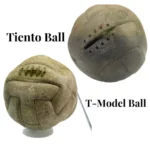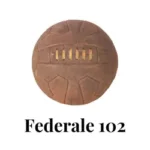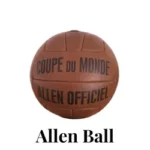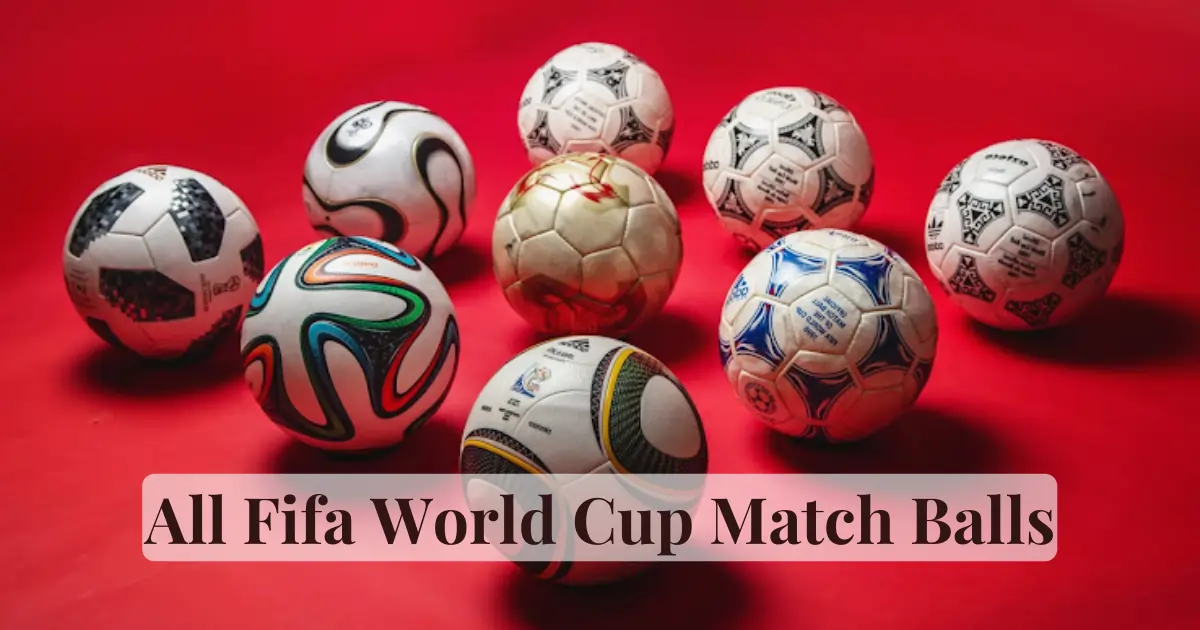FIFA has actively enhanced all aspects of the game, including match ball design advances. Fifa has added new technology that has been included in the ball design with time. Because of improving its version and making it weather resistant. Since the 1970s, Adidas has been the authorized ball supplier. Let discusses these balls in detail.
All FIFA World Cup Match Balls List
1930 Tiento & T-Model Balls

1934 Federale 102 Ball

1938 Allen Ball

Allen ball was used in the 1938 world cup. This ball was made with Leather, 13 panels, and different white thin-panel cotton lace. This world cup match ball was built in Paris.
1950 Duplo T Ball
1950 FIFA world cup, the ball used that name was the Superball made Duplo T. This ball. This was the 1st ball with no lace and came with a syringe valve.
1954 Swiss World Champion Ball
In the 1954 world cup, the swiss world champion ball was used by Kost Sport. This was the first ball that had 18 panels used in it.
1958 Top Star Ball
Top Star Ball was used in the 1974 FIFA world cup and selected after a blind test by four FIFA officials from 102 applicants. The Sydsvenska Läder och Remfabriken, Ängelholm, designed this ball.
1962 Crack Ball
The crack was the official ball used in the 1962 world cup. The first game’s Chilean ball didn’t satisfy referee Ken Aston, so he requested a European ball, which showed up in the second half. After that, separate balls were applied in different matches because European teams didn’t trust the made ball.
1966 Challenge 4-Star Ball
This ball was used in the 1966 world cup that the Slazenger designed. It has 18 yellow & white panels on the ball. The 4-Star ball was chosen in a random test by the headquarters of the Football Association in Soho Square.
1970 Telstar Ball
Telstar was the match ball used in the 1970 FIFA world cup. Adidas designed this ball. Telstar ball had the white & Black 32 panels, so this was used in the world cup final. In some matches, the brown ball was used by Germany & Peru and White by Italy & Germany in 1st half.
1974 Telstar Durlast Ball
Adidas also made this ball, which was used in the 1974 world cup. Duralast Ball was the first to have a polyurethane coating, making it waterproof and robust.
1978 Tango Ball
Up to 1988, this ball was also played at the Summer Olympics and UEFA European Championships.
1982 Tango España Ball
The Tango Espana featured a polyurethane coat, just like its previous version. However, it was the final leather ball to be used in the World Cup and had new and upgraded rubberized lines. Adidas also introduced this.
1986 Azteca Ball
Azteca was the first handmade ball, and its material was synthetic. Adidas manufactured this ball.
1990 Etrusco Unico Ball
In the 1990 FIFA world cup, the Etrusco Unico ball was used by Adidas.
1994 Questra Ball
Questra ball was used in the 1994 world cup. The Manufacture of this ball was Adidas.
1998 Tricolore Ball
Tricolore was the first multi-colored ball used in the FIFA world cup final match. Adidas created a ball for the 1999 Women’s World Cup that was unique and distinct from the Tricolore but identical.
2002 Fevernova Ball
Adidas introduced the Fevernova ball for the 2002 FIFA world cup, the first triangular ball. The 2003 Women’s World Cup ball was the same as the Fevernova, but it had a distinct style.
2006 Teamgeist Ball
This ball had 14 panels. At the World Cup finals, each match had a unique hop that was branded with the team names, stadium information, and the date of the game.
2010 Jabulani Ball
It features eight panels. The gold Jabulani, which was dubbed after “Jo’burg,” a common South African nickname for Johannesburg, the location of the final game, was a particular design used during the match.
The dispute surrounding the ball was remarkable because players and spectators claimed its dynamics were highly unpredictable.
2014 Brazuca & Brazuca Final Rio
2014 FIFA world cup Match Balls are Brazuca & Brazuca Final Rio. The fans have given this FIFA World Cup ball its first name. Six polyurethane panels have been joined together to form the ball. A separate color scheme for the championship game featured a green, gold, and black.
2018 Telstar 18 & Telstar Mechta
Teams compete using a ball designed after the original Adidas Telstar, which was used in the 1970 and 1974 World Cups for the 48 matches in the Group Stage.
After the group stage, FIFA released the Telstar Mechta (етa), a new color palette for the 16 games of the World Cup’s quarterfinal round. Mechta is the Russian word for “dream” or “ambition.”
2022 Al Rihla Ball
The first official match ball ever produced with water-based glues and inks was built with ecology as a top focus. Al Rihla, the ball’s name, is Arabic for “the travel” or “the expedition.”



